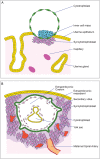The role of infection in miscarriage
- PMID: 26386469
- PMCID: PMC4664130
- DOI: 10.1093/humupd/dmv041
The role of infection in miscarriage
Abstract
Background: Miscarriage is the spontaneous loss of a pregnancy before 12 weeks (early miscarriage) or from 12 to 24 weeks (late miscarriage) of gestation. Miscarriage occurs in one in five pregnancies and can have considerable physiological and psychological implications for the patient. It is also associated with significant health care costs. There is evidence that potentially preventable infections may account for up to 15% of early miscarriages and up to 66% of late miscarriages. However, the provision of associated screening and management algorithms is inconsistent for newly pregnant women. Here, we review recent population-based studies on infections that have been shown to be associated with miscarriage.
Methods: Our aim was to examine where the current scientific focus lies with regards to the role of infection in miscarriage. Papers dating from June 2009 with key words 'miscarriage' and 'infection' or 'infections' were identified in PubMed (292 and 327 papers, respectively, on 2 June 2014). Relevant human studies (meta-analyses, case-control studies, cohort studies or case series) were included. Single case reports were excluded. The studies were scored based on the Newcastle - Ottawa Quality Assessment Scale.
Results: The association of systemic infections with malaria, brucellosis, cytomegalovirus and human immunodeficiency virus, dengue fever, influenza virus and of vaginal infection with bacterial vaginosis, with increased risk of miscarriage has been demonstrated. Q fever, adeno-associated virus, Bocavirus, Hepatitis C and Mycoplasma genitalium infections do not appear to affect pregnancy outcome. The effects of Chlamydia trachomatis, Toxoplasma gondii, human papillomavirus, herpes simplex virus, parvovirus B19, Hepatitis B and polyomavirus BK infections remain controversial, as some studies indicate increased miscarriage risk and others show no increased risk. The latest data on rubella and syphilis indicate increased antenatal screening worldwide and a decrease in the frequency of their reported associations with pregnancy failure. Though various pathogens have been associated with miscarriage, the mechanism(s) of infection-induced miscarriage are not yet fully elucidated.
Conclusions: Further research is required to clarify whether certain infections do increase miscarriage risk and whether screening of newly pregnant women for treatable infections would improve reproductive outcomes.
Keywords: female tract; infection; miscarriage; pregnancy.
© The Author 2015. Published by Oxford University Press on behalf of the European Society of Human Reproduction and Embryology.
Figures



References
-
- Abo-Shehada MN, Abu-Halaweh M. Seroprevalence of Brucella species among women with miscarriage in Jordan. East Mediterr Health J 2011;17:871–874. - PubMed
-
- Abo-Shehada MN, Odeh JS, Abu-Essud M, Abuharfeil N. Seroprevalence of Brucellosis among high risk people in Northern Jordan. Int J Epidemiol 1996;25:450–454. - PubMed
-
- Achache H, Revel A. Endometrial receptivity markers, the journey to successful embryo implantation. Hum Reprod Update 2006;12:731–746. - PubMed
-
- Aisemberg J, Vercelli C, Wolfson M, Salazar AI, Osycka-Salut C, Billi S, Ribeiro ML, Farina M, Franchi AM. Inflammatory agents involved in septic miscarriage. Neuroimmunomodulation 2010;17:150–152. - PubMed
Publication types
MeSH terms
Grants and funding
LinkOut - more resources
Full Text Sources
Other Literature Sources
Medical

